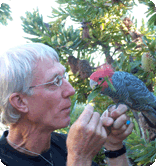Learning to Fly

Hi Eb, you helped us about 11 years ago (when we were living in Flagstaff AZ) to teach our macaw, Cyrano (then 2-3 yrs old, now 14 years old) to land by dropping her onto the bed. This was so she wouldn’t crash since as a clipped fledgling she never learned to fly or land and also to encourage her to flap her wings for exercise.
Fast-forward to now. We have a 4 year old Red-fronted macaw (Sorata) who fledged as a baby, is an adept flyer & loves to fly! And does throughout the house. Cyrano has continued to dislike it and never initiates flight. Seeing Sorata’s joy and fitness, we’ve been working with Cyrano the last 5 mo to fly short distances to us, and while she gets excited and has gotten better & lands on us, it still seems to scare her. She used to flap her wings while gripping onto us after baths but now doesn’t do that. She also used to flap to exhaust herself before Tom has to towel her for wing/beak clippings, but the other day she flew off him & crashed & hid under the chair, very scared. She seems nervous in our large bedroom where we fly her. We’re realizing it’s not worth it, that the whole flying thing stresses her, and that we’ll just quit & try to get her back to flapping while holding on to us. Do you agree - if so how do we get her back to just flapping? Or have any thoughts on if and how we can gently help her learn to like flying. We’re in a bit of a conundrum & just want her to be happy & healthy. As the alpha female, we’re also wondering if it’s stressful watching her kid sister fly all around so easily - but maybe that’s just fine for all. Thank you!

Linda, The one thing about flight training for fearful and never-fledged parrots is that it never really ends. At least not until they are totally skilled and strong and confident. For Cyrano to develop this type of flying, it will take lots of further progress from just the initial drop-and-flap training two or three feet off the bed with which you begin.
Every time he takes off in flight and/or crashes is essentially a step backward in his development. Hence these situations are to be avoided at all costs.
Yes, flapping exercise on the hand is good and will strengthen his torso, but much of landing has to do with technique and that just takes practice.
It would be best to analyze the WAY Cyrano flies. Does he always go straight ahead and end up going too fast to actually land well, hence falling forward on his face? Does he always fly down? Upwards? Parrots, especially large macaws, who over flap once taking off may gain too much speed and do not always have the skill to feather their wings, brake in the air, look downwards, put out their feet, and land on an object. In a household these things are even harder since macaws are evolved to fly hundred of yards at a time if they flap strongly. That’s why three and four and six-foot flap and lands are great indoor training.
If Cyrano is over-speeding, I would advise trimming the first two (sometimes later a third) strongest thick-ribbed flight feathers on each wing to slow his power down about 15%. This will not affect the landing progress.
You need to make this process as easy as possible for Cyrano, so that he does it time and again until it becomes second nature. One goes about this by establishing a comfortable and stable “landing site.” April and I use large handle baskets with our fledglings. They have the advantage of being able to be moved around the room to change flight patterns and visuals—but never change the recognizable landing site so that the bird begins to grow in confidence. Other such sites would be the back of a recliner draped with a large stable bath towel, or the wood on a portable perch (which does not shake 1) and can also be covered with the strong towel. Top of the cage with the towel, humans arm wrapped in the towel, etc, etc.
Get the point? Some 75% of correct landing for inexperienced birds is the mental aspect. That means that before taking off, the parrot that already KNOWS where he is going to try and land will have a singularly better chance of doing it smoothly. After fifty or a hundred such proper landings, you will notice that Cyrano begins to make an instantaneous decision WHILE AIRBORNE on where to land—say, by taking off, deciding to turn around in mid air, spotting his towel takeoff spot (obviously the more large towels of the same color around the room the better!) and returning to land on the same place.
This, by the way, illustrates the number on failure in most hand-feeding nursery fledging methods: the keepers do not control the mental side of the initial flights by establishing clear recognizable landing spots; instead they just let baby birds take off and go wherever they will and they end up with panicked chaotic crashes, impacts on windows, grabbing on door frames or picture frames or curtains, etc., instead of precise hop and flap landings on easily recognizable objects.
Regarding Sorata’s flying. I would venture that its always a bit stressful for a macaw that has been living alone to all-of-the-sudden be confronted with another large parrot flying around the room—-certainly if the Red Front flits by Cyrano or lands nearby or such. A parrot taking wing is a grand inducement for the nearby parrot to take off immediately also. Your Blue Throat (I believe it was…) would surely be drawn to fly in tandem on impulse, but being unable or fearful, would experience some fretfulness. Incidentally, an “alpha” bird as you termed it, is often the one that is the best flyer in the home. This might explain Cyrano’s increased nervousness or wish to avoid things by hiding under a chair.
It might be possible to devise some “games with treats” that prompt Sorata to fly from point A basket or soft spot to point B and back and forth, giving Cyrano a turn each time and a treat reward for joining in the game of practice flying.
Whatever you do, don’t give up! You have a golden opportunity here to improve the life of both your macaws. Just a little imagination and a lot of perseverance, and you will be quite pleased with the outcome.
With aloha, EB

































